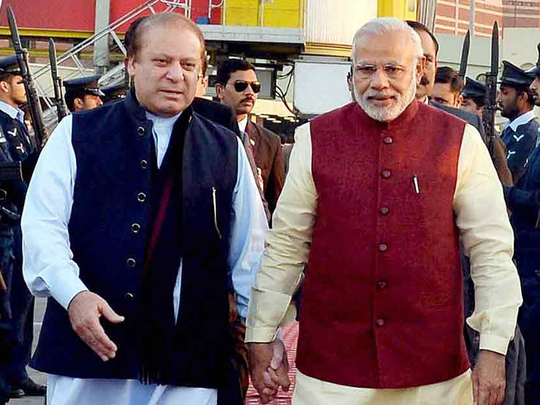
‘So you have finally come …”
“Yes, absolutely. I am here.”
A friendly banter? Could be — speaking in pure lexicological terms, that is. But seen through the prism of tenuous India-Pakistan relations, these words exchanged between Indian Prime Minister Narendra Modi and his Pakistani counterpart Nawaz Sharif on Christmas Day in Lahore may well turn out to be the beginning of a whole new era of bilateral parleys where the rigid propriety of copy-book protocol and a chronic dalliance with diplomatic one-upmanship need not necessarily be the flavours of the day.
It was Sharif’s 66th birthday and his granddaughter’s impending wedding the following day that were apparently the reasons behind Modi’s visit. And right from the time Modi expressed his desire to make a brief stopover at Lahore, the Pakistani establishment did everything it could to match vibes. From laying out the red carpet at Allama Iqbal International Airport, to serving the vegetarian Indian premier’s favourite ‘saag’ (spinach or other leafy vegetables) for an early dinner at Sharif’s family home of Jati Umra Raiwind, the hospitality complemented the surprise visit.
Yes, hawks on either side of the Wagah border wasted little time in trying to paint Friday’s off-the-cuff meeting between the heads of governments of two nuclear-armed neighbours as little more than mere optics, a purported display of bonhomie that was only skin-deep. So, while some analysts were quick to point out that Modi’s impromptu meeting with Sharif was just a ploy to defuse the tension within his own party, following the Bihar election debacle, there were others who felt that even with this unscheduled meeting, the Indian side’s flip-flop in dealing with Pakistan was laid bare. Critics will be critics, but let’s not miss the woods for the trees!
Modi’s 150-minute Lahore trip, on his way back to New Delhi from a tour of Russia and Afghanistan, is truly an out-of-the-box outreach, the kind of which the two nations have not seen since Partition in 1947. This is the first time in over a decade that an Indian prime minister has set foot on Pakistani soil. In that sense, when the Indian Air Force plane carrying Modi touched down at Lahore, it probably marked the creation of a new template for furthering India-Pakistan bilateral ties — a fresh canvas to try and chalk up a new roadmap for friendly relations between two neighbours who were separated at birth 68 years ago.
The apparent spontaneity of Friday’s meeting notwithstanding, there is no denying that Modi’s decision to touch base with Sharif did not happen in an instant. In fact, according to a section of the Pakistani media, the Lahore air traffic control was intimated on Thursday itself about Modi’s plane touching down on Friday.
Be that as it may, the Modi government was reportedly quite upset when bilateral talks between National Security Advisers (NSA) had to be scrapped this August, even though it was part of the joint declaration in Ufa, Russia, in July. Since then, officials at South Block (New Delhi) were keen on keeping Track Two parleys alive and Islamabad too responded favourably, which resulted in the meeting between the NSAs — Ajit Doval of India and Nasir Janjua of Pakistan — in Bangkok earlier this month. This was followed by a highly significant, Modi-Sharif tete-a-tete on the sidelines of the Paris climate summit, which paved the way for Indian Foreign Minister Sushma Swaraj’s sudden visit to Islamabad days later. While Swaraj’s trip happened without any of the hype and hoopla that are generally associated with such high-profile tours, it was a clear sign of the times: Both New Delhi and Islamabad were determined to establish a framework for furthering bilateral talks without throwing the script open for public scrutiny.
This is precisely where Modi and Sharif deserve to be given credit. Despite obvious political compulsions, they have both tried to keep the channels of communication open with the other side — tiding over a host of rancorous issues and keeping all temptations of chest-thumping at bay. During Swaraj’s visit, it was mutually decided that the respective foreign secretaries will work out the modalities for a comprehensive bilateral dialogue to cover issues such as Kashmir and cross-border terrorism. However, some experts on the Indian side had criticised the move, saying that New Delhi had actually allowed a dilution of the subject by “degrading” what should have been NSA-level talks to foreign secretary-level talks. But the point is, given the chequered history of India-Pakistan bilateral ties, it is perhaps time to go beyond the nitty gritties of such protocol-induced nuances and explore a more hands-on approach to diplomacy.
This is why Modi is so very right in making a pit-stop at Lahore. And this is where India’s principal opposition party Congress seems to have yet again lost the plot. Senior Congress leader Anand Sharma took a swipe at the Modi government, saying that India still doesn’t know what actually transpired in the meetings that the PM and his officials have been holding with their Pakistani counterparts since Ufa. Well, Sharma needs to be told in as many words that foreign policy game plan is no ball-park jamboree that calls for an open house. Moreover, Modi has at least shown the courage and smartness to walk offroad, seeing bumper-to-bumper traffic on the highway ahead. On the contrary, even ten long years were not enough for Sharma’s leader and former prime minister Manmohan Singh to decide on whether he should be taking a flight to Pakistan!
Modi has successfully packaged an element of surprise in his foreign policy doctrine. It remains to be seen how far the political establishments in both India and Pakistan are ready to take this outreach to the next level.
You can follow Sanjib Kumar Das on Twitter at www.twitter.com/@moumiayush








